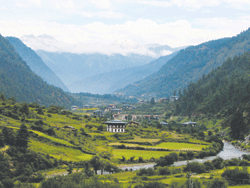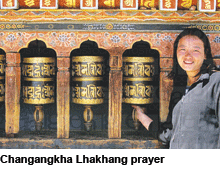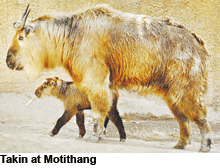An isolated kingdom sited in the deep Himalayas which claims to measure progress by a gross national happiness index, gradually westernising Bhutan may well be the world’s last Shangri-la. Yoginder Sikand reports
 Sandwiched between China (Tibet) in the north and India to the south, east and west, for almost a century the mountain Kingdom of Bhutan (pop. 738,267) has deliberately shunned modernity by cultivating a policy of isolation. Until a few years ago, it was difficult for travelers to visit the country. Even today — perhaps apprehensive of the devastating cultural and environmental impact of mass tourism — it isn’t easy to enter Bhutan. Non-Indian foreign tourists have to pay a sizeable daily fee, and Indians get only a seven-day permit, renewable with some difficulty, at the border. Yet, this has not reduced tourist footfalls in Bhutan, which are steadily increasing. Tourism is one of the country’s major sources of revenue, the others being export of electricity, timber, handicrafts and agricultural products.
Sandwiched between China (Tibet) in the north and India to the south, east and west, for almost a century the mountain Kingdom of Bhutan (pop. 738,267) has deliberately shunned modernity by cultivating a policy of isolation. Until a few years ago, it was difficult for travelers to visit the country. Even today — perhaps apprehensive of the devastating cultural and environmental impact of mass tourism — it isn’t easy to enter Bhutan. Non-Indian foreign tourists have to pay a sizeable daily fee, and Indians get only a seven-day permit, renewable with some difficulty, at the border. Yet, this has not reduced tourist footfalls in Bhutan, which are steadily increasing. Tourism is one of the country’s major sources of revenue, the others being export of electricity, timber, handicrafts and agricultural products.
In late November last year, after a bumpy three-hour ride in a tightly-packed van along a crater-ridden road, I arrived in the Indian town of Jaigaon in West Bengal’s Jalpaiguri district. Jaigaon is a typical Indian town — chaotic, filthy and noisy. Crossing an ornate gate into Bhutan I entered the pleasant town of Phuntsholing.
A model of urban planning in comparison, the streets of the town are neatly laid out, well-swept, and tree-lined, with broad pavements for pedestrians. The architecture of almost all buildings is in traditional Bhutanese style, mandated by law. Hoardings, billboards, advertise-ments, posters or slogans on the walls are strictly banned and conspicuously absent. Nor does music blare from shops, which are neatly whitewashed, with a standard green-colour board indicating its title and address. Garbage heaps, pavement stalls, and the crush of vehicular traffic ubiquitous in Indian towns, are virtually unknown in Phuntsholing (pop. 20,537). In the courtyard of a gaily-painted Buddhist temple, elders chatted in the sun while turning their prayer-wheels.
The contrast with India, visible from the grills of a wall beyond, couldn’t have been starker. As I was to discover during the next few days, Bhutan is a relatively prosperous country, and its government does much for its citizens, providing them free education, health-care, and generous scholarships to study abroad.
After a peaceful night in Phuntsholing, I took a van next morning to Thimphu, the country’s capital and largest town. The six-hour drive on the smooth, Indian-built road (most roads in the country have been built with Indian assistance), passed through stunningly scenic countryside — semi-tropical jungle for the first few hours, and as we climbed higher, pristine alpine forests spread over a profusion of Himalayan peaks that rose high into the clouds. Down below, a river fed by waterfalls spilling from mountain slopes cut a swathe. White prayer flags, mounted on tall wooden poles, fluttered in the wind, the sweeping vistas unimpeded by billboards or buildings. We passed a few small settlements as the van sped past quiet Buddhist temples, pyramid-like chortens or stupas, and neatly-built shops and houses, all constructed in indigenous architectural tradition with gilded, pagoda-style roofs, wooden windows with painted frames, and whitewashed walls embellished with religious motifs of floral and geometric patterns, dragons, tigers, snakes, snow lions, thunderbolts, and flying beasts.
 Surrounded on all sides by towering, thickly-forested mountains, Thimphu (pop. 200,000) is said to be the world’s smallest national capital capable of being circumnavigated within three hours. Thimphu is rapidly expanding, and feverish construction work (mostly with help of Indian and Nepalese labour) is underway in the suburbs, but compared with other South Asian towns, Thimphu is a delightful place to while away a few days. As elsewhere in Bhutan, the capital is — certainly by Indian stand-ards — clean and relaxed, the traffic orderly, and the people polite and helpful. One can stroll along the streets with ease.
Surrounded on all sides by towering, thickly-forested mountains, Thimphu (pop. 200,000) is said to be the world’s smallest national capital capable of being circumnavigated within three hours. Thimphu is rapidly expanding, and feverish construction work (mostly with help of Indian and Nepalese labour) is underway in the suburbs, but compared with other South Asian towns, Thimphu is a delightful place to while away a few days. As elsewhere in Bhutan, the capital is — certainly by Indian stand-ards — clean and relaxed, the traffic orderly, and the people polite and helpful. One can stroll along the streets with ease.
There’s enough to see in Thimphu to keep you going for a week, and perhaps the best way to explore it is on foot. At the far end of the town is the gigantic eighteenth century fortress-like Trashi Chhoe Dzong housing Bhutan’s government and monastic authorities. Close by are a host of places worth visiting. Among them is the National Institute of Traditional Medicine which offers treatments for a range of ailments using Himalayan minerals and herbs. This time-honoured Buddhist system of medicine is based on the premise that physical suffering is linked to unwhole-some mental conditions caused by ma-rig-pa or ignorance, manifested in anger, delusion and greed. Accordingly, it is widely believed that physical ailments can be cured if the underlying mental unwholesomeness is properly addressed.
The National Library of Bhutan is a repository of ancient Buddhist texts in Tibetan and Dzongkha (Bhutan’s official language) and should not be missed. It houses the world’s largest published book — certified by the Guinness Book of World Records — occupying a place of honour, weighing more than 60 kg. Nearby is the Textile Museum, showcasing a selection of brilliant hand-woven cloth from various parts of the country. Thimphu’s General Post Office contains a small museum exhibiting some of the country’s most amazing postage stamps, which were the rage at a time when philately was still a major hobby. For a modest charge, you can get a stamp imprinted with your picture, and you could also buy a stamp in the form of a CD!
On every visitor’s must-see list is the Institute of Zorig Chusum, where you can observe students honing their skills to make the beautiful crafts that Bhutan is famous for — carved wooden tables, giant masks, finely detailed thangka paintings with a range of religious motifs, statues of the Buddha and multi-limbed boddhisatvas.
 The vast majority of Bhutanese are Buddhists, and Thimphu is dotted with Buddhist temples (known as lhakhangs in Dzongkha). One of the oldest is the Changangkha Lhakhang, which affords a stupendous view of the valley below. Every inch of the inner walls of lhakhangs are richly decorated with frescoes of mythological figures and beasts, both ghoulish and benign, and various deities. Brightly-hued strips of cloth hang from the ceiling, and silken thangkas depict the Buddha and other figures in various postures. Enormous statues of a bewildering range of godlings and boddhisatvas adorn the centre of the prayer hall, in which a range of offerings — butter lamps, bowls of water, plastic flowers, painted figures made of stiffened butter, currency notes, grains, and packets of biscuits and chips — are placed. Popular Bhutanese religion isn’t quite the simple creed of the Buddha. It is suffused with mystery, superstition, rituals, myths, and populated by a host of what are believed to be divine beings — a mixture of Buddhism, Tantra and Bon-Po, the pre-Buddhist religions of Bhutan and Tibet.
The vast majority of Bhutanese are Buddhists, and Thimphu is dotted with Buddhist temples (known as lhakhangs in Dzongkha). One of the oldest is the Changangkha Lhakhang, which affords a stupendous view of the valley below. Every inch of the inner walls of lhakhangs are richly decorated with frescoes of mythological figures and beasts, both ghoulish and benign, and various deities. Brightly-hued strips of cloth hang from the ceiling, and silken thangkas depict the Buddha and other figures in various postures. Enormous statues of a bewildering range of godlings and boddhisatvas adorn the centre of the prayer hall, in which a range of offerings — butter lamps, bowls of water, plastic flowers, painted figures made of stiffened butter, currency notes, grains, and packets of biscuits and chips — are placed. Popular Bhutanese religion isn’t quite the simple creed of the Buddha. It is suffused with mystery, superstition, rituals, myths, and populated by a host of what are believed to be divine beings — a mixture of Buddhism, Tantra and Bon-Po, the pre-Buddhist religions of Bhutan and Tibet.
If you’ve had enough of trotting around museums and monasteries, you could spend hours window-shopping on Thimphu’s main street — Norzin Lam. This is where many of the town’s hotels are located, ranging from modest, tight-budget lodges to expensive five-star hostelries. Almost every second shop along Norzin Lam displays exquisite Bhutanese handicrafts, and there are a host of cosy, family-run confectionaries and eateries, where one can sample local dishes. One of the most popular is ema datsi — whole chillies cooked in yak milk cheese — advertised as Bhutan’s “national dish”. Across a wooden bridge festooned with prayer flags over a narrow brook, a lively flea market buzzes every weekend. Hundreds of neat little stalls, all run by women, transact brisk business in fresh vegetables and fruits. For those with a taste for the exotic, on sale are bits of dried yak cheese strung together like a necklace, packets of aromatic herbs, and bows with arrow quivers.
If you have the time and inclination, make a quick trip to Motithang to see the takin, Bhutan’s national animal which resembles a cross between a cow and goat. For moments of quietude, stroll the expansive lawns of Thimphu’s Botanical Gardens.
An hour’s drive from Thimphu, Paro boasts Bhutan’s only international airport. Quiet and picturesque, this little town is no hurry to catch up with the times. Rinpung Dzong is its star attraction. Its high walls enclose a warren of rooms for lamas, more than a dozen temples, and offices of the local administration, thus symbolising the duality of, and close nexus between religious and political authority. The painted woodwork enclosing these structures is exquisite, as are the walls wreathed with paintings of sages, frightening figures and boddhisatvas. If you are lucky, you might be able to watch a lama dance on the occasion of a tsechu or festival, when resident monks don colourful costumes and masks to present elaborate dances on different Buddhist themes.
 A 10-km drive from Paro is Bhutan’s most revered religious shrine: Taktsang (‘Tiger’s Lair’). The road to Taktsang weaves through verdant rice fields and sleepy villages, surrounded by high wooded mountains. Miraculously engineered atop a towering peak, on a sheer, precipitous cliff soaring 1,200 metres (3,600 ft) high, Takstang is reached after a tough two-hour climb. The narrow path to the top winds through pristine pine forests, giant prayer-wheels driven by streams rushing down the mountains, and quaint shrines decorated with strings of prayer flags, embossed with mantras and images of the Buddha. A thunderous waterfall spills out of the mountainside as one approaches the Tiger’s Lair, which is a collection of small temples built into the rock face, and marks the area where the eighth century Guru Padmasambhava, widely venerated as the tutelary deity of the country, is said to have meditated for three years, three months, three weeks, three days and three hours. Known locally as Guru Rinpoche (‘the precious one’), Padmasambhava is believed to have brought Buddhism from India into Bhutan.
A 10-km drive from Paro is Bhutan’s most revered religious shrine: Taktsang (‘Tiger’s Lair’). The road to Taktsang weaves through verdant rice fields and sleepy villages, surrounded by high wooded mountains. Miraculously engineered atop a towering peak, on a sheer, precipitous cliff soaring 1,200 metres (3,600 ft) high, Takstang is reached after a tough two-hour climb. The narrow path to the top winds through pristine pine forests, giant prayer-wheels driven by streams rushing down the mountains, and quaint shrines decorated with strings of prayer flags, embossed with mantras and images of the Buddha. A thunderous waterfall spills out of the mountainside as one approaches the Tiger’s Lair, which is a collection of small temples built into the rock face, and marks the area where the eighth century Guru Padmasambhava, widely venerated as the tutelary deity of the country, is said to have meditated for three years, three months, three weeks, three days and three hours. Known locally as Guru Rinpoche (‘the precious one’), Padmasambhava is believed to have brought Buddhism from India into Bhutan.
 The several temples in the complex are splendid works of art. They are adorned with giant statues and clusters of ornate thangkas. But if you’ve already seen enough Bhutanese temples, they won’t strike you as very distinct, for after a point they exhibit the same features. What’s definitely unique are vistas of densely-forested mountain peaks all around, and floating clouds splitting over emerald green fields below. Also check out a temple trumpet made of a human thigh bone and used for ritual worship.
The several temples in the complex are splendid works of art. They are adorned with giant statues and clusters of ornate thangkas. But if you’ve already seen enough Bhutanese temples, they won’t strike you as very distinct, for after a point they exhibit the same features. What’s definitely unique are vistas of densely-forested mountain peaks all around, and floating clouds splitting over emerald green fields below. Also check out a temple trumpet made of a human thigh bone and used for ritual worship.
There’s definitely a lot more to see in Bhutan apart from Thimphu and Paro. But what’s displayed in the glossy leaflets handed out by the country’s authorities describing it as the last Shangri-la and “mysterious land of the thunder dragon’’, will be hard to find. As elsewhere across the world, Bhutan is modernising rapidly notwithstanding the government’s claim to the contrary. Nevertheless, its relatively untouched charm makes it worth a visit, for the taste of a rapidly vanish-ing culture, and Himalayan flora and fauna which its enlightened rulers have done much to preserve.